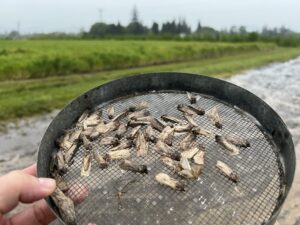Pleased to announce I was invited to participate in a nationwide analysis of corn earworm trends. This new study from Dr. Lawton (NC State) et al. takes a look at decades-long trapping and soil temperature data to provide some insight into overwintering potential of H. zea, and how we might use models to predict pest abundance. Highlights from the article:
Continue readingCategory Archives: monitoring
Week 12
Quick update:
- The data table is available (.pdf download); all regional trap counts are within normal limits.
- The commercial broccoli field at Gervais (GRVS) has been harvested.
- New traps have been set to detect pests in commercial sweet corn – those counts will be available by next week.
- **The new “Oregon Pest Monitoring Network” is now available! This collaborative effort between USDA-ARS and OSU provides real-time access to data, including a map of trap locations.
- To view observations, select the “Pest Observation Dashboard” tab.
- Use filters to see activity graphs for specific pests or crops.
- The system also includes a “Report a Pest” function, where growers or reps can inform staff of concerns.
- If you have noticed a recent reduction of efficacy in the products you use for diamondback moth, please consider taking a short, anonymous survey:

Peridroma saucia is common in Oregon. But for the past three years, we are detecting them at much higher-than-normal levels in early spring.
The graph below shows pheromone trap counts (# of adult moths per day) in recent years vs. a long term average. Please note that all data points before May 10th are NOT regional averages. They represent only the Corvallis location. These 5 single-location data points are filled with a dot pattern (hard to see, sorry). However, in 2020, the true regional average (peach diamonds) remained higher than normal until June 1st.
Continue readingScouting and Control of Diamondback Moth
Identifying Immature Insects
You’ll notice that we emphasize the importance of ‘scouting’ on this blog a lot, but what is one supposed to do when they find something? Lots of immature bugs can be found in the soil and it can be difficult to distinguish a “baby” beetle from a fly from a caterpillar, etc. This post might help…
Continue readingMaggots: gross impact of a gross group
After this morning’s invited speaker talk (OPVC Annual Grower Meeting), I thought it might be helpful to assemble some existing resources we have about Delia spp. in the PNW. Browsing these links could help you better prepare for the planting season. Also feel free to leave a comment with any specific concerns or impact you’ve experienced. Thanks to Dr. Nault for a great presentation this morning!
- ** VegNet alert – late June 2020 – Seedcorn maggot issues reported/confirmed in snap bean and parsnip
- ** Pest profile page – Seedcorn maggot species complex, literature
- ** Pest profile page – Cabbage maggot overview, ID, management
- Temporal trends – late July 2018 – Temporal trends and species complex info
- Scouting report – mid Oct 2020 – Maggot complex found in stored onion
- Research report (pdf) – 2016 maggot trial in direct-seeded radish, chlorpyrifos alternatives
- VegNet alert – May 2018 – Poor emergence, general info seedcorn maggot
- U. of Mass. factsheet – Seedcorn maggot
- Dr. Brian Nault, lab site – Cornell Entomology (pdf) – Delayed planting to help manage onion maggot

Root Maggots of the PNW – Overview
| Delia species (Diptera: Anthomyiidae). Small (5-8mm) flies – black, brown or grey – the immature phase are called maggots – they feed on root and sometimes stem tissue – identification technical and difficult* – often referred to as a rootfly ‘complex’. Adults do not cause damage. Eggs are laid at the base of plants. Maggots tunnel into tissue which causes direct damage and also increases the risk of infection by plant pathogens. | . |
| D. radicum: Cabbage maggot Our most familiar regional issue. Adults prefer cool weather and maturing (4-7 leaf) brassica plants to lay eggs. Flight period well-documented and can be useful for predicting timing of egg-laying pressure. HOSTS: weedy mustards, broccoli, cauliflower, etc. | . |
| D. platura: Seedcorn maggot Attracted to organic matter and decay. Sometimes worse in fields that have been cover cropped to increase N. Often a secondary pest (invades after initial decay of tissue due to other factors). Active earlier than other species. HOSTS: many, but especially large seeded vegetables like corn, peas, dry beans, snap beans | . |
| D. florilega: Bean seed maggot Nearly indistinguishable from D. platura, often occur together. HOSTS: association is broad, but mostly a problem in turnips, radish, canola | . |
| D. planipalpis: Western radish maggot Similar in appearance to D. radicum, but different leg hair arrangement. HOSTS: radish and canola (verified in literature); also probably other crucifers | |
| D. antigua: Onion maggot A major problem in onion production. Many good resources available. HOSTS: onions, garlic, chives, etc. | . |
| D. floralis: Turnip maggot Similar in appearance to other species; different leg hair arrangement. HOSTS: turnip and radish |
Leafrollers & Leaftiers
Larvae of various Tortricid moths (Lepidoptera: Tortricidae) are well-known pests to fruit and nut growers, but less considered in vegetables. Here is a quick list of some economically important species in this group:
- Light Brown Apple Moth (Epiphyas postvittana)
- Fruittree Leafroller (Archips argyrospila)
- Codling Moth (Cydia pomonella)
- Filbertworm Moth (Cydia latiferreana)
- Strawberry Fruit Worm aka Omnivorous Leaftier (Cnephasia longana)
These small, bland colored moths are nearly undetectable in the landscape, but their larvae can cause billions of dollars of economic damage. Leaves are rolled or tied to provide shelter for developing larvae. Crop damage from this group can occur ‘from root to fruit’. Read more and see photos below…
Continue reading